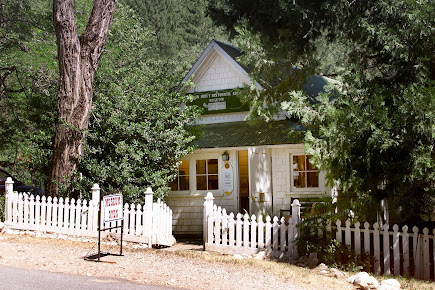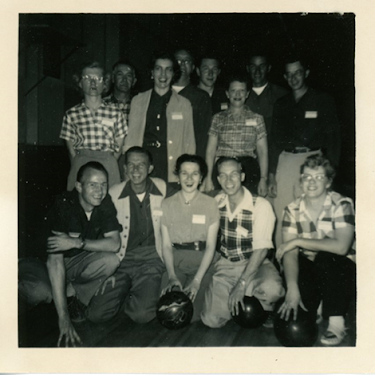Administrator’s Notes
by Ralph Gibson, Museums Administrator
It’s almost March and that means we’re just wrapping up the winter Gold Rush 4th Grade program at the Gold Rush Museum and Spring Living History is around the corner. It’s going to be a very busy spring with Living History at two sites, preparations for Heritage Trail 2025, and our Exhibit Team breaking ground on a new exhibit that may take more than a year to complete.
As I mentioned in the last issue, I plan to retire soon and my last day will likely be this fall. Until then, I thought I’d take a gander at what was happening in the Museums Division 20 years ago when I had just started.
In February of 2005, the Museums Department became a Division of the Facility Services Department; Parent Teacher training for Living History had four sessions in February and March of 2005 with 28 teachers and 142 parents attending (all our trainings are virtual now!); It’s in the Bag, the first exhibit that Exhibit Technician, Jason Adair and I worked on, opened on February 10, 2005; and on March 26, 2005, Dr. Bob LaPierre gave a presentation on Gold Rush Medicine in our Placer County Museum gallery.
That’s all for now. I’ll keep bringing up stories from the memory vault with each article until my last.
New Donation Highlight
by Kasia Woroniecka , Curator of Collections
This ribbon of the Order of the Knights of Pythias dates to around 1895, when the Colfax Lodge No. 200 was established.
The Knights of Pythias is a fraternal organization founded in 1864 by Justus H. Rathbone, who was inspired by the Greek legend of two friends, Damon and Pythias. When Pythias is sentenced to death by a tyrant ruler, he is allowed to leave temporarily to settle his affairs and Damon agrees to take his place as a hostage, knowing he will die if his friend does not return on time. When Pythias returns as promised, the tyrant , moved by their loyalty, releases both friends. The core principles of the Knights of Pythias are "Friendship, Charity, and Benevolence," and the organization’s rituals and teachings are based on the friendship between Damon and Pythias.
There are over 2000 Knights of Pythias lodges today that continue participating in community service projects, volunteering in local charities and hosting social events.
Golden Drift Historical Society and Museum
by Sarah Fugate, President
Members of the Golden Drift Historical Society (GDHS) fund efforts to preserve and promote the rich history of our area. For just $25 per year, you can be a part of our accomplishments.
In 2024, the Golden Drift Historical Society collaborated with the Chinese Historical and Cultural Project and Placer County to restore Dutch Flat’s Chinese Cemetery. They hosted a successful Dutch Flat History Day and funded the restoration of historical school banners at the Dutch Flat Community Center. GDHS also supported the digitization of the Isaac Coffin Diary, now displayed at the Golden Drift Museum. With grant funds, they built a traditional funerary burner in the Chinese Cemetery and ensured it is fire-safe. GDHS is a self-governing membership organization that uses dues and donations to fund educational initiatives and public events.
To continue to serve our mission, we need to increase membership. Please take a moment to renew your membership, and encourage others to join our society as well. Please visit our website, www.goldendrift.org. Your dues and donations to the society are tax deductible.
Thank you for your support. See you at the museum!
Rolling Through History: The 1953 PG&E Bowling Tournament
by Kelsey Monahan, Curator of Archives
This photograph shows the Pacific Gas and Electric (PG&E) Drum Division team at the Pacific Services Association (PSEA) Bowling Tournament held in Oakland in April 1953. June Brackett of the Drum Division, which was headquartered in Auburn, had the highest scratch score of all 81 women bowlers. The photo comes form the scrapbook of Helen Gold, who was the Drum Division’s PSEA Women’s Affairs Chairman in 1953. Other photographs in the album show the varied activities of the group including Christmas parties, luncheons, and tours.
Helen, born Helen Brusso, was born in 1921 in Roseville where her father was an engineer for the Southern Pacific Railroad. She graduated from Roseville High School and Placer Junior College before working at Mather Field and later with PG&E. She was married to Pershing Jay Gold from 1941 until his death in 1952, from complications around his rescue efforts for the passengers of the stranded City of San Francisco train near Colfax. She remarried to James A. Wheat in 1958 before his death the next year in 1959. In 1960, she married Ted L. Chamberlain. In addition to working for PG&E Helen was very active in the community, and was involved with Friends of the Placer County Library, Arts Council of Placer County, Placer County Parks Commission, and the Crocker Art Museum.
Thank you to docent and Archives volunteer Marti Fischer who has done such an amazing job cataloging and scanning the collection with Helen’s photographs (and so much more!).
SNOW Sports Museum
by Scott Keith, SNOW Sports Museum Advisor
In the spring of 2024, the SNOW Sports Museum made a significant discovery—the original architect's model of Blyth Arena, hidden in storage at the Oakland Museum of California (OMCA). Upon recognizing its historical value, museum advisor Scott Keith contacted OMCA to discuss restoring the model. With support from the Placer Country TOT-TBID Dollars at Work program, additional funding was secured for its restoration. On January 17, 2024, the model was transported to the SNOW Sports Museum Archive at the Auburn Ski Club Training Center. After a new table is constructed, it will be displayed at the interim SNOW Sports Museum at the Boatworks Mall in Tahoe City in March. Designed by architect Russel Francis Stechschulte, the model symbolizes the modern design movement and innovative spirit of the 1960 Winter Olympics. Its return offers visitors a rare, tangible connection to California’s Olympic legacy and its groundbreaking architectural contributions.
Western States Trail Museum
by Christina Richter, Secretary, Western States Trail Museum Board of Directors
In 2018 the Western States Trail Museum Articles of Incorporation for a non-profit entity were filed, and in August of 2023 a lease was signed with the City of Auburn for the future museum space. Anticipation is high as the extensive infrastructure improvement and build out continues at 1103 High Street, space #300, in Auburn, CA.
To see the progress for our vision firsthand be sure to find us on the Heritage Trail this summer!
Volunteer Spotlight
by Katy Bartosh, Curator of Education
For this issue’s Volunteer Spotlight I spoke with Loretta Saenz, who volunteers at the Gold Rush Museum.
Loretta started volunteering with us because she was interested in the local history of the mountains where she hikes. Even though she doesn’t work with me in education programming, she enjoys seeing and interacting with the kids who come to the museum. “They’re super excited!”
Loretta also enjoys hearing all the stories that people bring with them to the museums. If you’re lucky enough to have worked with Loretta before, you probably know she was a librarian in her past life so I had to ask her for a book recommendation. “The End of Drum-Time, by Hanna Pylväinen”.
Thank you for being such a great volunteer, Loretta!
Maidu Museum and Historic Site
Maidu Museum & Historic Site (MMHS) is excited to announce the upcoming Yoomén - A Celebration of Spring event, scheduled for Saturday, April 26, 2025, from 10:00 AM to 3:00 PM. This annual FREE event marks the arrival of spring, a time to celebrate new growth, fresh foods, and warmer weather.
SummaYoomén is a celebration of Native American culture featuring performances by Indigenous dancers, cultural demonstrations like basket weaving and jewelry making, and artwork displays by local Native artists. The event includes activities for children, such as Native-inspired art and game stations, as well as guided tours of the museum and ancient petroglyphs. Elders from nearby communities will be honored for their contributions to cultural preservation. Thanks to the support of Sierra Native Alliance, the event is free to the public, making it a valuable opportunity for cultural exchange and community celebration.
We look forward to celebrating with our community at Yoomén: A Celebration of Spring!
Benton Welty Historical Classroom—Celebrate Our Story
Come to Auburn City Hall the second Saturday of the month from 1:00-4:00 pm and celebrate City Hall’s/Auburn Grammar School’s 110th Birthday!
The beautiful Auburn Grammar School was built in 1915 with all the modern amenities: indoor plumbing, electricity, central heat, a dining room, auditorium and eight spacious classrooms.
Every second Saturday afternoon of the month starting March 8th, there will be grand tours, children’s activities, opportunities for reminiscing, displays, a Benton Welty Historical Classroom visit, and an Auburn History Lecture Series.
The topic for the first lecture will be Early Auburn – Why did Auburn thrive while other Gold Rush towns did not?
This year long celebration will culminate on Saturday, January 10th, 2026. January 10th, 1916 was the day 110 years ago the doors opened for the students.
Placer County Historical Society
Dinner MeetingWhen:
Thursday, April 3, 2025 Meeting at 6:00, Dinner at 6:15, Speaker at 6:45
Jim Wood on the history of the lime industry in Placer County
Location: Veterans Memorial Hall Dinner cost: $30.00.
100 East Street, Auburn, CA Speaker presentation: Free
Please RSVP to rsvp.pchs@gmail.com
Please go to www.placercountyhistoricalsociety.org for more information
Placer County Historical Organizations
Colfax Area Historical Society
Jay McIntyre, President, (530) 346-8599
colfaxhistory.org
Donner Summit Historical Society
Bill Oudegeest, (209) 606-6859
donnersummithistoricalsociety.org
Foresthill Divide Historical Society
Annie DeMaria-Norris (916) 206-4479 foresthillhistory.org
Fruitvale School Hall
Community Association
Mark Fowler
Golden Drift Historical Society
Sarah Fugate, (530) 389-2121
Historical Advisory Board
Glenn Vineyard, (916) 747-1961
Joss House Museum and
Chinese History Center
Larry Finney, (530) 305-9380
Lincoln Area Archives Museum
Elizabeth Jansen, (916) 645-3800
laamca.org
Lincoln Highway Association
Trey Pitsenberger
vice.president@lincolnhighwayassoc.org
Loomis Basin Historical Society
Karen Clifford, (916) 663-3871
www.loomisbasinhistory.org
Maidu Museum & Historic Site
Kaitlin Kincade, (916) 774-5934
roseville.ca.us/indianmuseum
The Museum of Sierra Ski History and 1960 Winter Olympics
David C. Antonucci, (775) 722-3502
tahoemuseum.org
Native Sons of the Golden West
Parlor #59
Dave Allen, (530) 878-2878 dsallen59@sbcglobal.net
Newcastle Portuguese Hall
Association
Mario Farinha, (530) 269-2412
North Lake Tahoe Historical Society
Phil Sexton, (530) 583-1762
northtahoemuseums.org
Placer County Genealogical Society
Diane Fishburn
http://www.placergenealogy.org
Placer County Historical Society
April McDonald-Loomis
(530) 823-2128
placercountyhistoricalsociety.org
Placer County Museums Docent Guild
Craig Norris
Placer Sierra Railroad Heritage Society
Chuck Spinks
Psrhs.org
Rocklin Historical Society
Gloria Beverage (916) 624-3464
rocklinhistorical@gmail.com
Roseville Historical Society
Denise Fiddyment, (916) 773-3003
rosevillehistorical.org
Calendar:
Please confirm all meeting times and locations with each organizationForesthill Divide Historical Society Meeting:
Monday, March 17th at 6:00 p.m.
Golden Drift Historical Society Meeting:
Monday, April 7th at 7:00 p.m.
Historical Advisory Board Meeting:
Wednesday, April 16th at 5:30 p.m.
Loomis Basin Historical Society Meeting: Wednesday, March 19th at 6:00 p.m.
Placer County Historical Society Meeting: Thursday, March 6th at 2:00 p.m.
Placer Sierra Railroad Heritage Society: Tuesday, March 25th at 7:00 p.m.
Rocklin Historical Society Meeting: Tuesday, March 11th at 6:30 p.m.
Roseville Historical Society Meeting: Tuesday, March 11th at 4:00 p.m.












































